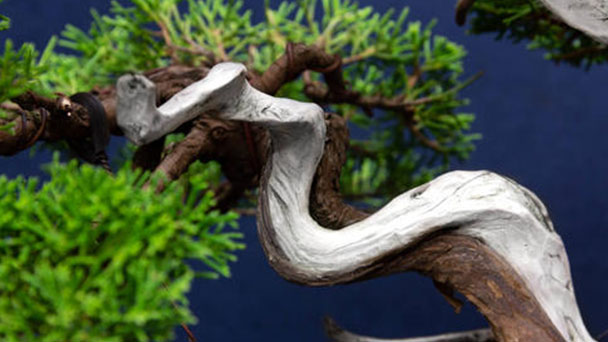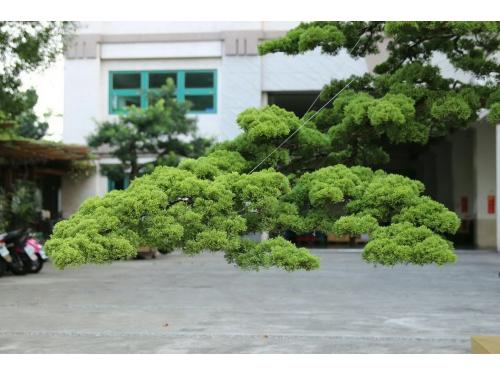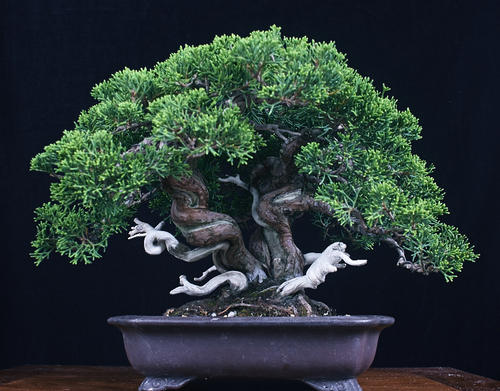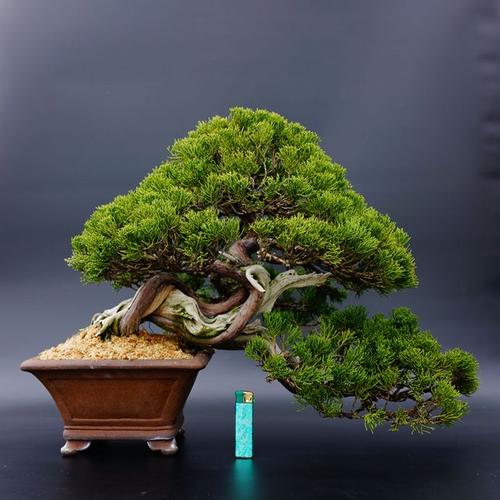Chinese juniper (Juniperus chinensis) profile
Written by Maggie
Aug 25 2021

Chinese juniper (Juniperus chinensis) is a creeping shrub of the family Cupressaceae, up to 75 cm tall, branches extending to the ground, brown, dense branchlets, branches and branchlets oblique upward.
Chinese juniper picture

Chinese juniper info
| Botanical Name | Juniperus chinensis |
| Common Names | Chinese juniper |
| Plant Type | Shrub, tree |
| Sun | Part shade to full shade |
| Hardiness Zones | 4–9 (USDA) |
| Flower color | Yellow to bronze (no ornamental value) |
| Native Area | Asia |
| Mature size | 2–40+ ft. tall, 15–20+ ft. wide |
Mphological characteristics of Chinese juniper
Spiny leaves of Chinese juniper are trifoliate cross whorls, strip-lanceolate, apex acuminate into a keratin sharp, 6-8 mm long, concave above, with two white powder stomatal zones, stomatal zones often confluence in the upper part, green midrib only lower obvious, not up to the apex of the leaves, convex below, blue-green, along the midrib with a fine longitudinal groove. Cones are subglobose, pinkish, black at maturity, 8 -- 9 mm in diameter, with 2 -- 3 seeds; Seeds ca. are 4 mm, ridged.
Ecological habits of Chinese juniper
Chinese juniper likes light, slightly shade tolerance, strong cold resistance, also endure barren, can be born in the rock cracks; The soil requirements are not strict, neutral soil, calcareous soil can adapt.But the soil with fertile, deep and rich humus is the most appropriate.
The distribution region of Chinese Juniper
Chinese juniper is distributed in Zhangguangcai Mountains in northeast China, 1400 meters above sea level.Soviet Union, Japan also has distribution.
The propagation of Chinese juniper
Chinese juniper is usually propagated by cuttings or layering. Cutting to the best annual shoots, the spike length of 10 ~ 15 cm, cut the middle of the following twigs, inserted deep 1B2; Seedbed with leaf rot soil mixed with sand soil, appropriate fertile loose, good drainage. Pour permeable after insertion, shade at any time, 2 ~ 3 months can take root. The following spring for sub-transplantation, breeding seedlings. chinese juniper often grows on the creeping ground, and adventitious roots occur, so it can also propagate by layering method. Chinese juniper is also easy to survive by grafting and breeding with cypress obliterata or cypress lateralis seedlings as rootstocks.
How to grow and care for Chinese juniper
Choose the basin
Chinese juniper is appropriate to use purple porcelain pottery basins, large bonsai can also use chiseled stone basins. The shape of the basin in deep rectangle, oval, square, round, hexagonal and other appropriate;Cliff type available deep thousand barrel basin.
The clay
Chinese juniper should be used fertile loose neutral soil or calcareous soil.Potted commonly used humus mixed with charcoal chips or mixed with sand.
Pruning
Size and shape vary widely among Chinese juniper plants, and this will dictate your specific pruning needs. But in general, pruning is typically best done annually in the late winter or early spring just before growth begins. Prune off any dead, broken, or diseased branches. And then trim back leggy branches to maintain the plant’s shape. Aim to selectively prune branches around the entire plant to increase the amount of light that can reach its center.
If you're looking to form pompom shapes out of a Chinese juniper shrub, some people opt to fashion a circular guide for themselves out of wires. You also can find pre-made guides at garden centers for this purpose. Simply place the guide over your plant, and remove the foliage outside of it.
Moreover, you can eyeball the cuts if you're comfortable doing so. Chinese juniper tends to be very forgiving of slight pruning mistakes. So if you prune a bit too much, just give the plant a little growth time to correct your mistake. For pompoms, prune around three to four times a year to promote denser growth.
Plant
It should be carried out in spring, and also in autumn. Planting should pay attention to the hole in the basin with tiles pad empty, in order to facilitate water permeable. On a potted Chinese juniper, the first water should be poured, after a little dry and then poured.
Molding
Chinese Juniper's molding processing is based on climbing and supplemented by pruning. Generally, it is more convenient to use metal wire to climb, stretch and bend freely, and the branches can be twisted to show the elegance of the ancient cypress. When climbing, the main branches should be tied up, and the twigs can be tied up or pruned.
The local branches of Chinese juniper can be made into withered branches, which is called "relic stem". It imitates the phenomenon of some branches breaking off and bark peeling off of trees in nature due to long-term wind, rain, lightning and lightning attacks, thus producing a quotidious and peculiar effect.
When making, you can select some branches (often use the branches of Chinese juniper that you did not need originally), cut off the small branches and leaves, remove the bark from the base, can be cut with a knife, and can also be peeled with your fingers. The branch tip must be cut into a natural broken shape, and strive not to reveal artificial traces. Finally, the peeled branches are coated with a lime and sulfur mixture to prevent decay." The position arrangement of sari stem is very important, it plays a role in adjusting the density of the whole cypress tree shape and increasing the contrast changes, so it should be carefully considered. Cheryl stem "can be in the top of the tree, also can be in the middle of the branch, according to modelling needs and decisions.

The tree shape
The natural growth of the ancient cypress is often twisted, chinese juniper tree can also be made into a curved dry type, followed by cliff type, oblique dry type and horizontal dry type. The trunk of the curving type must be zigzagging and changeful, and special attention must be paid to the changes in the direction and degree of bending. Cliff type, oblique dry type and lie dry type trunk also cannot be too straight, and appropriate belt a few minutes bend. The branches and leaves of Chinese juniper should be made into clusters, and may hang down appropriately.In addition, local branches of Chinese juniper can also be made into "sarira stem".
Chinese juniper originate from high mountains and should be called "deep mountain Chinese juniper". It was domesticated artificially and cultivated on the flat ground. The leaves are superimposed and the scales are rope shaped. Chinese Juniper is suitable for all kinds of climates in the south and north regions of the mainland.Good material for bonsai.
Chinese juniper disease & pests
Needle blights in wet springs can be a problem; can be susceptible to cedar apple rust.
Chinese juniper varieties
There are many cultivars of Chinese juniper that serve different landscape purposes. They include:
Blue Point Chinese juniper (Juniperus chinensis 'Blue Point'): This plant grows in a dense pyramid shape at least eight feet tall and features blue-green foliage.
Gold Lace Chinese juniper (Juniperus chinensis 'Gold Lace'): This is a compact shrub with golden foliage, growing only to around three to four feet tall with a little wider spread.
Pfitzer Chinese juniper (Juniperus chinensis 'Pfitzeriana'): This shrub grows around five to 10 feet tall and 15 to 20 feet wide, and it features sage green foliage.
The purpose of Chinese juniper
Chinese juniper is a good material for bonsai and is used for viewing bonsai.

Latest Updated
- Benefits of Bugleweed - 7 Science-backed Health Benefits
- Bugleweed Dangers & Side Effects - Is It Poisonous?
- How to Plant Evergreen Trees - What You Should Know
- When to Plant Evergreens - Grow Guide for Evergreen Trees
- 12 Wonderful Evergreen Shrubs for Your Garden
- 12 Popular Evergreen Plants with Pictures for Beginners
- When And How To Prune A Lilac Bush Like a Pro
- How to Grow & Care for Lilac Vine (Hardenbergia Violacea)
- Japanese Lilac Tree (Syringa Reticulata) Care & Propagation Guide
- Shumard Oak Pros and Cons - What to Know
Popular Articles
- Winter maintenance of Antirrhinum Majus
- How to Grow Terminalia Mantaly Tree
- How to Grow and Care for Crossostephium Chinense
- How to grow Antirrhinum Majus in spring
- Peristeria Elata (Dove Orchid) Profile: Info & Care Guide
- Underwatered Snake Plant (Sansevieria Trifasciata) - Signs And How To Fix
- How to Care for Brazilian Jasmine Plant (Mandevilla Sanderi)
- How to Grow & Care for Graptopetalum Purple Delight in Summer
- Rosa Chinensis (China Rose): Plant Growing & Care Tips
- How to Care for Baby Sun Rose (Aptenia Cordifolia)